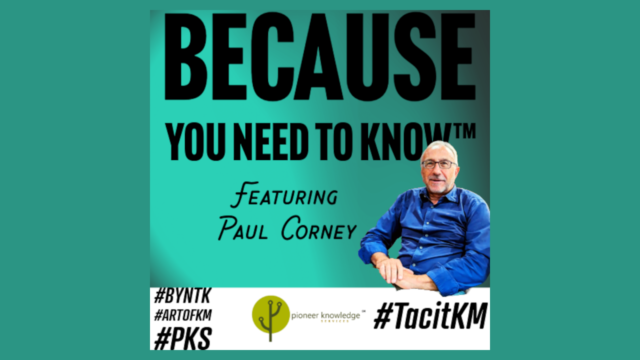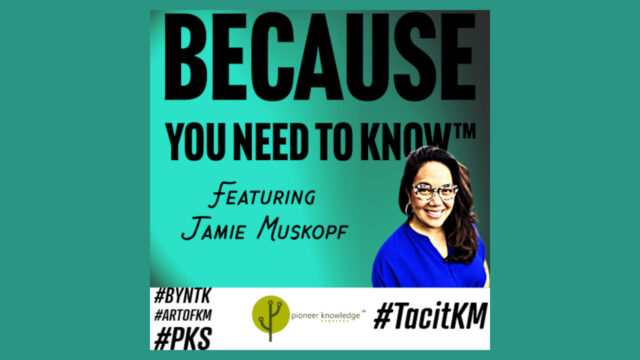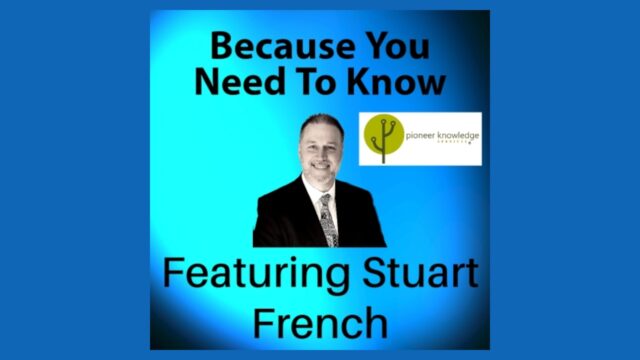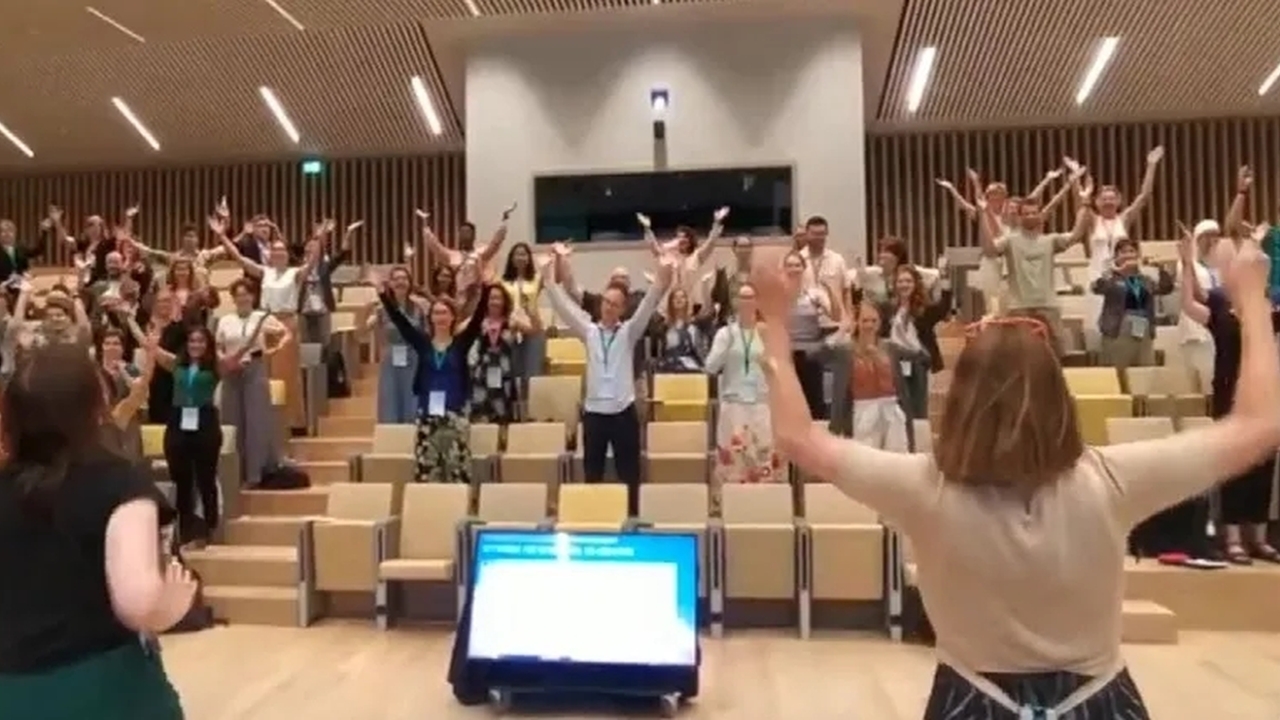
Not just in our heads: Embodied and creative practices for creating connection [Arts & culture in KM part 14]
By Corinne Lamain and Jillian Student. Originally published on the Integration and Implementation Insights blog.
How can embodied and creative practices, such as dance and poetry, be used to bridge different forms of knowledge?
Transdisciplinarity requires crossing many boundaries, including knowledge fields, perspectives, languages, personalities, and geographic areas. This is often somewhat uncomfortable. Arts-based and embodied approaches can support creative thinking, perspective-taking and communication. For some, these art-based methods feel more natural than for others, but we suggest that the willingness to leave our comfort zone (‘embracing the discomfort’) opens up space for shared vulnerability that is much needed for integrating perspectives. Moreover, doing these practices under time pressure helps remove the tendency to self-criticise and strive for perfection in artistic expression. To be fair, creative practices are not everyone’s style. It is important to note that the effort is not about co-creating beautiful artwork, but rather to facilitate alternative means of expression.
We put these principles into practice when we organised the TRED (Transdisciplinary Research, Education and Dialogue) conference in 2023. At that conference we drew on metaphors, poetry, drawing and dancing as creative and embodied practices.
Metaphors
When working across boundaries, it is easy to get lost in translation. Metaphors are powerful tools to create shared understanding. They appeal to the imagination and thus de-link us from specific scientific terminologies and their related mindsets. During the conference, metaphors opened up pathways for describing how people perceive collaborations. During the opening plenary on the second day of the conference – Interact Tuesday – participants were asked to come up with a metaphor that described their experience in transdisciplinary research. After a minute of silence to think of a metaphor, we used an ‘oil spill method’ to converse about the metaphor. Using this method, participants started by speaking with their neighbour in pairs about their metaphor. After two minutes, we invited them to team up with another pair and continue the conversation for three minutes. This brought about a lively chat across the room in which everyone had a chance to speak, probably also with someone they did not already know. Participants were invited to note down their metaphors on an inspiration board that was present in the lounge throughout the conference and where any other thought, contribution, initiative, or request could be posted.
Poetry
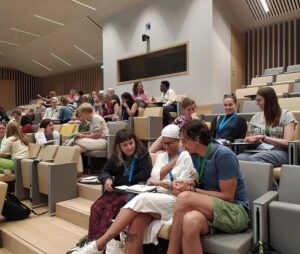
Poetry, such as Haiku, opens up a space to play with words and images and enables a more emotional engagement with a topic. Haiku is a form of poetry that helps break down a message into its essentials through its conciseness and rules for syllables and lines (5-7-5 syllables, respectively, in three lines). When determining core principles, Haiku poems can help teams to express underlying values. During the conference, the participants wrote Haiku poems using self-selected words and words that were inspired by others. In a plenary exercise that we called ‘release your inner poet’, participants followed a stepwise approach to co-creating Haiku poems. First, in silence, they wrote down keywords for meaningful co-creation for two minutes. Second, participants were invited to chat with their neighbour for five minutes about their keywords and why they chose them. The third step was to select at least one keyword from their neighbour. Step four was when participants composed one or more Haiku poems using at least one self-chosen keyword and one selected from their neighbour. Some participants decided to do this in a group, as they found it difficult to do this alone. Afterwards (step five), the poems were entered in Wooclap (an online tool to collect and display input from a room), so everyone could read them. Participants were invited to read their Haiku poems out loud. The Haiku poems were creative, thoughtful and sharp. We owe Meghann Ormond (Wageningen University and Research) gratitude for introducing us to this exercise.
Examples of the Haiku poems written during the conference are:
A dialogue starting
And equal we are
Co-creation is
A sense of shared ownership
In humble service
Tangled in context
Quiet strength to make changes
Rooted in fairness
Listening and trust
we cocreate together
respect the process
Drawing
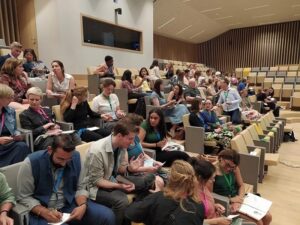
Emotions can be difficult to verbalise in professional settings. However, bringing our full human self is key to come to truly integrative knowledge collaborations. Drawing is an alternative approach to engaging with emotions, especially the tougher ones like fear, anxiety and anger. On the third day of the conference – Integrate Wednesday – drawing was used by means of an ice breaker during the opening plenary session. Everyone was invited to draw for themselves in three minutes a story of being part of a process of integrating knowledge (ie., collaboration). We emphasised that we were not seeking works of art, but rather offering an opportunity to explore a different way of expressing. This was followed by a conversation with one or more neighbours about what they drew and why. We collected the drawings on the inspiration board, so that conversations around them could continue in the breaks.
Drawing was also used as a method to report on the second day of the conference. Two professional artists were hired to make a visual summary of the conference, as shown in the image below.
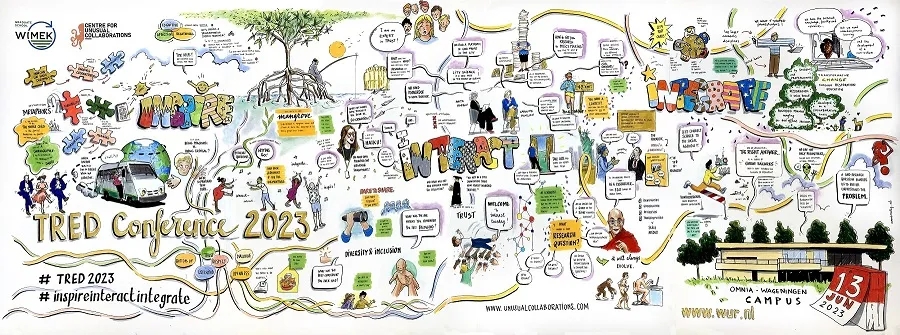
Dancing
There is no better way to practice being comfortable with discomfort than co-creating a dance and performing it together! In addition to the creative methods described above, dancing was a key practice during the conference. Dancing as an embodied approach helps to move beyond engaging the mind to also physically experience collaboration. Singing and dancing are some of the most ancient collective rituals. At the TRED conference, dancing was part of the opening session and during the conference new moves were co-created.
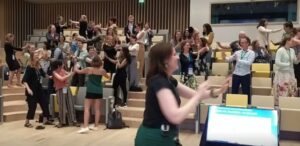
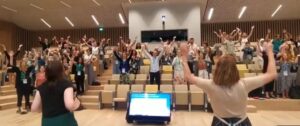
How did that work? Before even officially welcoming the participants, the co-hosts opened the conference with a dance move for each of the three central concepts for the conference: ‘inspire’, ‘interact’ and ‘integrate’. The audience in the room, albeit a little hesitant at the start, quickly stood up and joined in the dance. A surprising and energetic opening that truly embodied the awkwardness, boldness and beauty of co-creating collaboratively! Throughout the conference, we collectively co-created a longer choreography. The participants determined concepts that emerged from other plenary activities and conference sessions. Together, we selected and co-created new moves for ‘trust’, ‘collaborate’ and ‘celebrate’. This led to energetic moments of dance throughout the conference.
In conclusion
By applying creative and embodied methods in the plenary sessions, we were not just talking about co-creation, but we facilitated the co-creation of the conference. Some people stated they were a bit reluctant at the start, but the participants’ responses were generally really positive: people had not expected to be able to write a Haiku poem or make a drawing. Many found it a joyful experience to create something new and unexpected with others.
Creative and embodied methods are new and potentially uncomfortable for many people. To set the scene for creative and embodied methods, we think three things were key. One, we invited participants to bring an open attitude and try things they may not initially see the purpose of, to ‘embrace discomfort’. Two, we encouraged participants to focus on exploration and not perfection. And finally, we led by example and did not expose participants to tasks that we were not willing to engage in ourselves. We showed our vulnerability, by starting the conference by dancing alone, sharing our metaphors and keywords, and writing our own poems. Together, these key elements helped open up space for shared vulnerability that is much needed for integrating perspectives.
How have you used embodied and creative practices to create connection? What has been your reaction as a participant in such activities?
To find out more:
For more information on the conference, see: TRED (Transdisciplinary Research, Education and Dialogue) conference. (2023). Co-creating space for collaborative research and learning to inspire, interact and integrate, 12-14 June, 2023, Wageningen University and Research. (Online): https://www.wur.nl/en/activity/tred-conference-2023-co-creating-space-for-collaborative-research-and-learning-to-inspire-interact-and-integrate.htm
Although we do not describe any of the listed methods in this blog post, we were inspired by: Pearson, K. R., Backman, M., Grenni, S., Moriggi, A., Pisters, S. and Vrieze de, A. (2018). Arts-Based Methods for Transformative Engagement: A Toolkit. SUSPLACE Innovation Training Network: Wageningen, Netherlands. (Online – open access) (DOI): https://doi.org/10.18174/441523
Copyright note: The authors have the rights to use the images. Conference participants consented to the use of images taken during the conference for external communication purposes.
Biographies:
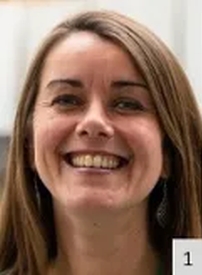 |
Corinne Lamain MSc is Director of the Centre for Unusual Collaborations, The Netherlands. She works on facilitating knowledge production that contributes to environmental justice, especially through transdisciplinary research. She is also a PhD candidate working on the militarization of climate action at the International Institute for Social Studies located in The Hague, The Netherlands. |
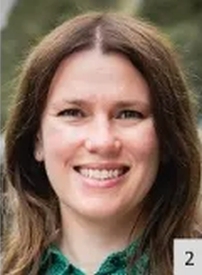 |
Jillian Student PhD is a postdoctoral researcher on inter- and transdisciplinarity at WIMEK (Wageningen Institute for Environment and Climate Research), Wageningen University and Research, the Netherlands. Her research integrates different scientific disciplines, forms of knowledge and approaches to better understand emerging environmental changes that affect and are affected by human decision-making. |
Article source: Not just in our heads: Embodied and creative practices for creating connection. Republished by permission.
Header image: Co-creating dance moves around transdisciplinary collaborations (source: taken from a video recorded by Corinne Lamain).

